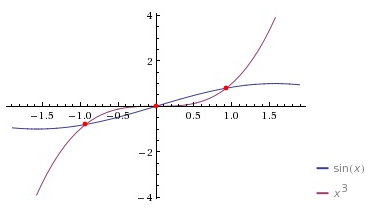
To find: The solution of the equation
Answer to Problem 60E
The solution of the equation
Explanation of Solution
Given information:
The given equation is
Calculation:
Using graphing device.
Let’s plot graph for the two functions. The left hand side is displayed in blue, while the right hand side is in purple.
The graph is shown in figure (1).

Figure (1)
The intersection (the solution) are indicated by red dots. So, there are three visible solutions.
Based on what we know about sin function, the solution of
There may be solution outside of our visible viewing window. Then we zoom out, we see that there are only three solutions. The graph in figure (2) sets the

Figure (2)
We can deduce that three solution are.
To graph of two functions on a TI calculator, first press the
In order to find the intersections of the two functions (which represent the solutions to the equation that equate them), first press the
It will say
The
Therefore, the solution of the equation
Chapter 7 Solutions
Precalculus: Mathematics for Calculus - 6th Edition
- An open-top rectangular box is being constructed to hold a volume of 150 in³. The base of the box is made from a material costing 7 cents/in². The front of the box must be decorated, and will cost 11 cents/in². The remainder of the sides will cost 3 cents/in². Find the dimensions that will minimize the cost of constructing this box. Please show your answers to at least 4 decimal places. Front width: Depth: in. in. Height: in.arrow_forwardFind and classify the critical points of z = (x² – 8x) (y² – 6y). Local maximums: Local minimums: Saddle points: - For each classification, enter a list of ordered pairs (x, y) where the max/min/saddle occurs. Enter DNE if there are no points for a classification.arrow_forwardSuppose that f(x, y, z) = (x − 2)² + (y – 2)² + (z − 2)² with 0 < x, y, z and x+y+z≤ 10. 1. The critical point of f(x, y, z) is at (a, b, c). Then a = b = C = 2. Absolute minimum of f(x, y, z) is and the absolute maximum isarrow_forward
- The spread of an infectious disease is often modeled using the following autonomous differential equation: dI - - BI(N − I) − MI, dt where I is the number of infected people, N is the total size of the population being modeled, ẞ is a constant determining the rate of transmission, and μ is the rate at which people recover from infection. Close a) (5 points) Suppose ẞ = 0.01, N = 1000, and µ = 2. Find all equilibria. b) (5 points) For the equilbria in part a), determine whether each is stable or unstable. c) (3 points) Suppose ƒ(I) = d. Draw a phase plot of f against I. (You can use Wolfram Alpha or Desmos to plot the function, or draw the dt function by hand.) Identify the equilibria as stable or unstable in the graph. d) (2 points) Explain the biological meaning of these equilibria being stable or unstable.arrow_forwardFind the indefinite integral. Check Answer: 7x 4 + 1x dxarrow_forwardshow sketcharrow_forward
- Find the indefinite integral. Check Answer: 7x 4 + 1x dxarrow_forwardQuestion 1: Evaluate the following indefinite integrals. a) (5 points) sin(2x) 1 + cos² (x) dx b) (5 points) t(2t+5)³ dt c) (5 points) √ (In(v²)+1) 4 -dv ขarrow_forwardFind the indefinite integral. Check Answer: In(5x) dx xarrow_forward
 Calculus: Early TranscendentalsCalculusISBN:9781285741550Author:James StewartPublisher:Cengage Learning
Calculus: Early TranscendentalsCalculusISBN:9781285741550Author:James StewartPublisher:Cengage Learning Thomas' Calculus (14th Edition)CalculusISBN:9780134438986Author:Joel R. Hass, Christopher E. Heil, Maurice D. WeirPublisher:PEARSON
Thomas' Calculus (14th Edition)CalculusISBN:9780134438986Author:Joel R. Hass, Christopher E. Heil, Maurice D. WeirPublisher:PEARSON Calculus: Early Transcendentals (3rd Edition)CalculusISBN:9780134763644Author:William L. Briggs, Lyle Cochran, Bernard Gillett, Eric SchulzPublisher:PEARSON
Calculus: Early Transcendentals (3rd Edition)CalculusISBN:9780134763644Author:William L. Briggs, Lyle Cochran, Bernard Gillett, Eric SchulzPublisher:PEARSON Calculus: Early TranscendentalsCalculusISBN:9781319050740Author:Jon Rogawski, Colin Adams, Robert FranzosaPublisher:W. H. Freeman
Calculus: Early TranscendentalsCalculusISBN:9781319050740Author:Jon Rogawski, Colin Adams, Robert FranzosaPublisher:W. H. Freeman
 Calculus: Early Transcendental FunctionsCalculusISBN:9781337552516Author:Ron Larson, Bruce H. EdwardsPublisher:Cengage Learning
Calculus: Early Transcendental FunctionsCalculusISBN:9781337552516Author:Ron Larson, Bruce H. EdwardsPublisher:Cengage Learning





